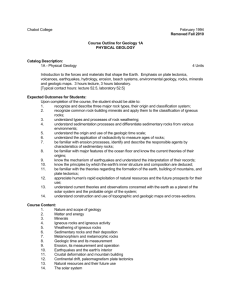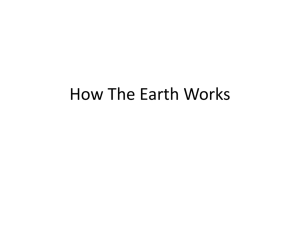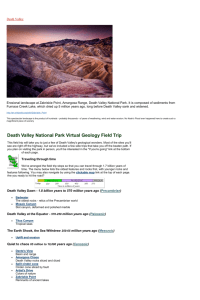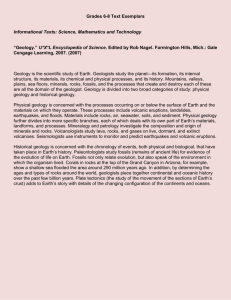Death Valley Today
advertisement
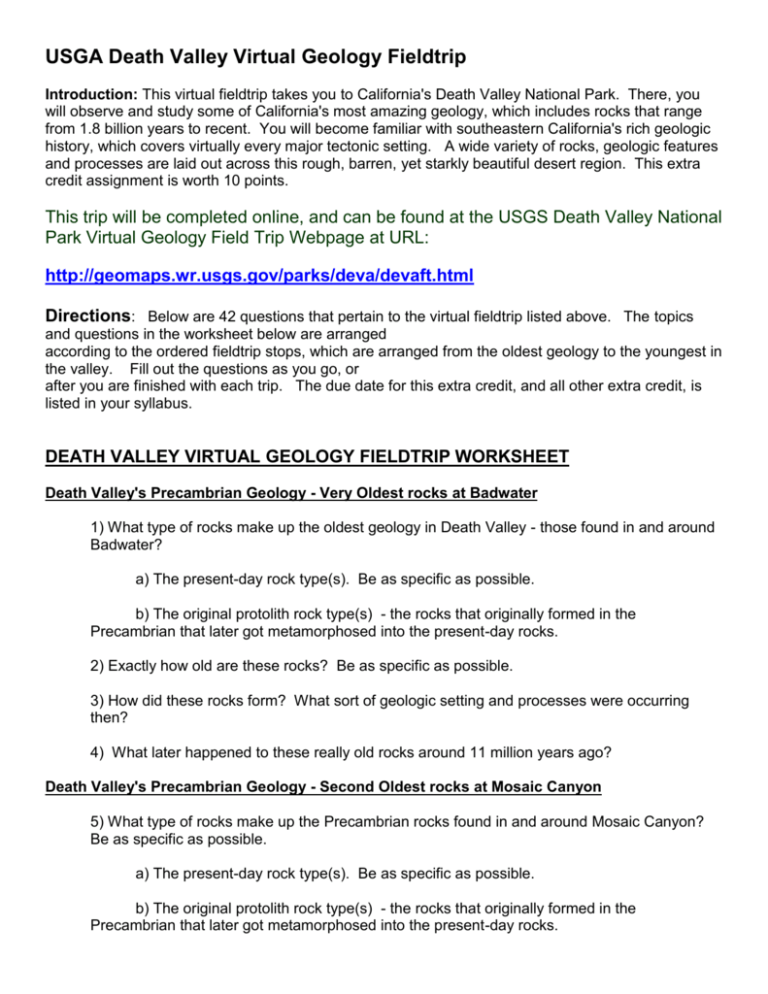
USGA Death Valley Virtual Geology Fieldtrip Introduction: This virtual fieldtrip takes you to California's Death Valley National Park. There, you will observe and study some of California's most amazing geology, which includes rocks that range from 1.8 billion years to recent. You will become familiar with southeastern California's rich geologic history, which covers virtually every major tectonic setting. A wide variety of rocks, geologic features and processes are laid out across this rough, barren, yet starkly beautiful desert region. This extra credit assignment is worth 10 points. This trip will be completed online, and can be found at the USGS Death Valley National Park Virtual Geology Field Trip Webpage at URL: http://geomaps.wr.usgs.gov/parks/deva/devaft.html Directions: Below are 42 questions that pertain to the virtual fieldtrip listed above. The topics and questions in the worksheet below are arranged according to the ordered fieldtrip stops, which are arranged from the oldest geology to the youngest in the valley. Fill out the questions as you go, or after you are finished with each trip. The due date for this extra credit, and all other extra credit, is listed in your syllabus. DEATH VALLEY VIRTUAL GEOLOGY FIELDTRIP WORKSHEET Death Valley's Precambrian Geology - Very Oldest rocks at Badwater 1) What type of rocks make up the oldest geology in Death Valley - those found in and around Badwater? a) The present-day rock type(s). Be as specific as possible. b) The original protolith rock type(s) - the rocks that originally formed in the Precambrian that later got metamorphosed into the present-day rocks. 2) Exactly how old are these rocks? Be as specific as possible. 3) How did these rocks form? What sort of geologic setting and processes were occurring then? 4) What later happened to these really old rocks around 11 million years ago? Death Valley's Precambrian Geology - Second Oldest rocks at Mosaic Canyon 5) What type of rocks make up the Precambrian rocks found in and around Mosaic Canyon? Be as specific as possible. a) The present-day rock type(s). Be as specific as possible. b) The original protolith rock type(s) - the rocks that originally formed in the Precambrian that later got metamorphosed into the present-day rocks. 6) Exactly how old are these rocks? Be as specific as possible. 7) What was the geologic setting like when these rocks were being deposited? Death Valley's Early Paleozoic Geology - Limey Rocks of Titus Canyon 8) What type of rocks make up the Cambrian rocks found in and around Titus Canyon? Be as specific as possible. 9) Exactly how old are these rocks? Be as specific as possible. 10) What was the geologic setting like when these rocks were being deposited? Climate? Depositional environment? 11) Are there any traces of fossils in these rocks? If so, what kind? 12) Would this region at that time have been considered a passive or active continental margin? State your reasoning. Death Valley's Late Paleozoic - Mesozoic Geology - Rocks of Western Death Valley 13) What major tectonic changes had occurred to this region by the late Paleozoic and on in through the Mesozoic? a) The change in plate tectonic setting - from what setting to what setting? Be as specific as possible. b) The initiation of what sorts of geologic activities? Creation of what sorts of geologic features? 14) What was the total range in age for this geologically very active period of time for this region? 15) What types of rock were being formed by these sorts of geologic activities? Be as specific as possible. 16) What is the name of the world-famous batholith that was forming at the same time to the west of Death Valley? 17) The geologic processes that formed these Mesozoic rocks (that you listed in 16) were also responsible for what other valuable mineral deposits here? Death Valley's Cenozoic Geology - Basin and Range Geology - Dante's View and Amargosa Chaos 18) What major tectonic changes had occurred between the Late Mesozoic and Late Cenozoic? a) What new tectonic setting that caused the Basin and Range structures to form? Be as specific as possible. b) What sorts of geologic activities created the Basin and Range geology? Be as specific as possible. c) What type of faulting created Death Valley's classic basin-and-range style of geography? Normal, reverse, or strike-slip? Extensional, compressional, or shear? 19) What were the two Cenozoic epochs for when most of the extensional tectonics occurred? Also note the absolute age range. Death Valley's Recent Volcanic Geology - Split Cinder Cone 20) What type of volcanism has occurred in Death Valley in recent times? Be as specific as possible. 21) Why did the volcanism create a cinder cone and not a shield volcano or composite volcano? 22) What caused the cinder cone to split into two pieces? Describe the crustal motion. Death Valley's Technocolor Geology - Black Mountain 23) What type of rocks make up the Artist's Drive Formation? Be as specific as possible. 24) Why are the Artist's Drive Formation rocks so colorful? Be as specific as possible. 25) What is "desert varnish"? Death Valley's Badland Geology - Zabriskie Point 26) What are "badlands"? How do they form? 27) What sort of rainfall patterns does Death Valley have? Does rainfall patterns play a role in badland development? How? Death Valley's Great Alluvial Fans - View from Golden Canyon 28) What are "alluvial fans"? How do they form? 29) Does rainfall patterns play a role in alluvial fan development? How? Include in you discussion flash-flooding. 30) Does topography play a role in alluvial fan development? How? 31) What rock types are created in an alluvial fan depositional setting? Death Valley and the Ice Ages - Shoreline Butte 32) What epoch did the last Ice Age occur? Include the age in years. 33) Describe the type of climate that Death Valley had back then. 34) Describe the type of geography that Death Valley had back then, due to the Ice Age climate. 35) Describe the lake that Death Valley had back then. Death Valley Today - Back to Badwater and Big Dunes 36) What is the lowest elevation in Death Valley? 37) Describe the type of climate that Death Valley has today. 38) Describe the sorts of lakes that Death Valley has today, compared to the ones during the last Ice Age. 39) How do those rocks glide across the Racetrack Playa? 40) How does Death Valley develop its enormous sand dunes? 41) What sorts of valuable minerals are mined around Death Valley National Park? 42) Have you ever visited Death Valley? If so, what was your experience like? If not, then would you like to visit Death Valley some day? Why?


